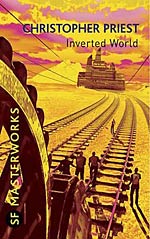
![]() spectru
spectru
9/14/2014
![]()
The Inverted World is written in straightforward unpretentious prose. Christopher Priest is British but his writing is somewhat similar to Isaac Asimov's. It's comfortable to read and moves ahead smoothly at a good pace. There is not a strong plot. The story is the revelation of the strange conditions in which the characters live. The telling of the tale moves back and forth from first person to third person and one part of the book is written from the point of view of one other than the main character. This isn't problematic, but it's noticeable. This is a good hard science fiction novel. Its premise is original and clever.
SPOILER Along with our protagonist Helward Mann, through his guild apprenticeship, we learn the unusual natural laws of his world. It is a world whose shape is hyperbolic rather than spherical. That is, it is shaped like a solid hyperbola, y=1/x, rotated about the y axis. North is asymptotic on the y axis, toward the pole and south is asymptotic on the x axis, toward the equator. Time and space are distorted more and more the farther one is from the optimum, that is, the point on the hyperbolic surface where x=1. When one travels south from the optimum, the centrifugal force created by the spinning of the planet overcomes the force of gravity creating a pull parallel to the surface of the ground, i.e. towards the equator. The land is inexorably (and inexplicably) moving from the pole towards the equator at the rate of about a tenth of a mile a day and this is what causes the big problem for the people who live in the city. The city must be physically moved, relentlessly, to keep it near the optimum. This is done by winching it along tracks that are laid ahead and taken up behind. Otherwise it would move away from the optimum and into the area of increasing spatial-temporal distortion and would be destroyed by the centrifugal force. There are people living in settlements along the path of the city who seem not to be affected by the distortions, or at least not in the same way that the people of the city are affected.
Well into the story a character from outside the city, Elizabeth Khan, is introduced. Liz tries to convince the people of the city that she is from England, that they are on Earth, not some other planet, that it really is spherical but that their perceptions have been distorted by their electric power generator, which isn't really nuclear fueled. She explains how their situation came into being and that in the 200 years that they've been pulling the city they've traveled 7000 miles from China to Portugal. In the end, facing the daunting task of trying to build a bridge across a vast river that is actually the Atlantic Ocean, our hero, Helward, remains unconvinced,. END SPOLER
Little by little the strange way of the world is revealed. I had a hard time imagining it until finally the hyperbolic shape is explained as being defined by the formula y=1/x. Then finally it made sense and I could visualize it. (Simple high school geometry. Don't you remember?) There were some interesting technological anomalies: They had video cameras, electric bogies (trucks or wagons), a (supposedly) nuclear power generator yet the militia uses crossbows and all the heavy work is done by manual labor. There is no heavy construction equipment or even power tools. Most of the things I wondered about as the story progressed are eventually explained and became clear. In the end, the major question remains revealed, but unresolved, in a kind of Twilight Zonesque finish.